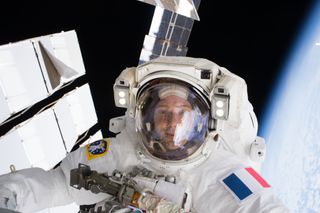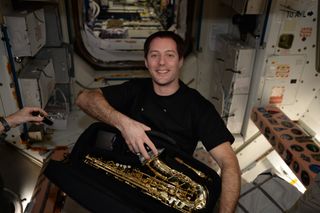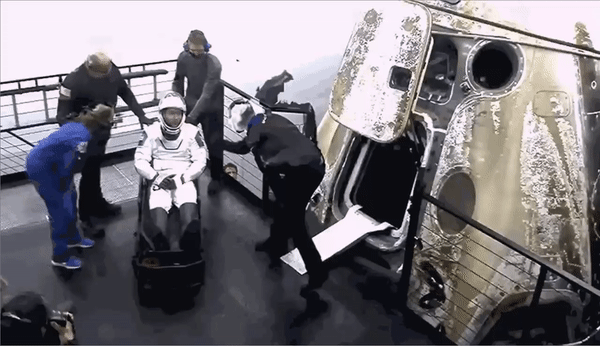Thomas Pesquet: 1st French astronaut to command the International Space Station
Thomas Pesquet is a European Space Agency astronaut who was the first person from France to command the International Space Station.
While Pesquet’s background is in spacecraft design and control, he is also well-known for engagement activities in space such as playing music or performing regular tours of the International Space Station (ISS). He even performed the saxophone from space during the closing ceremonies of the 2020 Olympics (held in 2021 due to the pandemic), as Paris will be the host of the 2024 Summer Games.
During Pesquet’s first mission, he flew to the ISS on a Russian Soyuz and spent 197 days in space between 2016 and 2017 as a flight engineer for Expeditions 50 and 51. Pesquet, who recently served during Expeditions 65, 66 and 67, arrived at the ISS again on April 23, 2021 and returned to Earth on Nov. 8, 2021, aboard the SpaceX Crew-2 Crew Dragon.
Early life
Pesquet was born in Rouen, roughly two hours’ drive from Paris, on Feb. 27, 1978, according to the European Space Agency (ESA). After completing state secondary school at Lycée Pierre Corneille in 1998, Pesquet studied spacecraft design and control at the National Higher French Institute of Aeronautics and Space in Toulouse, a well-known French hub for aerospace. Pesquet spent his final year of school studying under an exchange program at Canada’s Polytechnique Montréal (then known as Polytechnique School), before graduating with a master’s degree in 2001.
Following graduation, ESA stated, Pesquet’s early career positions included trainee engineer with Thales Alenia Space (where he developed a satellite system design tool) and spacecraft dynamics engineer at GMV S.A. in Madrid (with a focus on remote sensing missions.)
Pesquet then joined the French space agency, CNES, in 2002 as a research engineer studying space mission autonomy — what we might today term a part of « artificial intelligence » or « machine learning, » which has to do with how spacecraft can make decisions with a minimum of human intervention. Pesquet also was a CNES representative at the Consultative Committee for Space Data Systems, allowing him to work with international space agencies on various projects.
In between his studies and his employment, Pesquet picked up a private pilot’s license and was selected in 2004 to join Air France’s flight training program, ESA stated. He was subsequently hired as a commercial pilot and flew one of Airbus’ workhorse airliners, the A320, starting in 2006.
Joining the astronaut corps
In an interview with Connexion France in 2011, Pesquet said that this background was not typical of an astronaut, as only military pilots had been selected before he. That said, being both an engineer and a pilot is a more typical experience of astronauts.
He added he was lucky to have a recruitment drive available to Europeans in 2009, since the previous one was in 1992 when he was still a teenager. But Pesquet did have a lifelong interest in space, that he was glad to pursue, when called upon. « I dreamed of it, without really believing in it, » he said in the interview. « I couldn’t really say to myself I would be an astronaut, [as] it seemed a bit mad. Many are called and few are chosen. »
Around the time Pesquet was selected as astronaut in September 2009, he not only logged thousands of flight hours on commercial airliners, according to ESA, but he also was an A320 type rating instructor — meaning, an instructor with the ability to train other pilots on a particular multi-pilot airplane type. Pesquet also served as an instructor in Crew Resource Management, which trains pilots and ground personnel on how to work with each other during flight conditions (both normal and emergency).
Typical new astronaut selectees are assigned to « astronaut candidacy » training, and are called ASCANs (short for « astronaut candidates ») until they pass a series of basic training in spaceflight skills ranging from spacewalking to Russian language training to ISS systems briefings. Pesquet completed his basic training in November 2010 and, like many new astronauts before him, took on mission support jobs such as acting as a Eurocom (a European communicator with astronauts during spaceflights), and engaging with China for future spaceflight projects, his ESA biography states.
Pesquet also took on « analog » missions, or missions that simulate some of the isolation and danger of spaceflight in a controlled environment on Earth. He was a 2011 participant in Sardinia, Italy in the ESA CAVES program (Cooperative Adventure for Valuing and Exercising human behavior and performance Skills). Beyond mission contributions, Pesquet took a few minutes to create « cave art » posted to the ESA website.
Pesquet also joined a crew as a support member — staying above ground — for a NASA mission at the underwater Aquarius laboratory in 2013, called SEATEST II (Space Environment Analog for Testing EVA Systems and Training). Such missions are usually performed to test crew members and new technologies alike under space-like conditions.
For example, Pesquet later recalled for ESA what it was like to test communications with the crew under an artificial 20-minute time delay similar to what one may experience for real during Martian missions, due to the distance between Mars and Earth. « Our communication became more formal, » he said. « There was less time for chatter. We had to anticipate possible questions and provide the answers before they were asked. »
First spaceflight: Proxima

Pesquet was assigned to a standard six-month spaceflight — his flight was called « Proxima, » after the star Proxima Centauri — for the ISS in March 2014. After the normal two years of mission training, Pesquet and the rest of the Expedition 50/51 crew launched to the orbiting complex on Nov. 17, 2016. Pesquet was the 10th astronaut from France and the first one to launch in nine years, ESA stated in his biography.
« His busy mission was the first to see all four cargo vehicles in operation at the time — HTV, Cygnus, Dragon and Progress — travelling to the space station. He tracked and captured two of them using the station’s robotic arm, » ESA said. In addition, Pesquet participated in more than 50 experiments and performed two spacewalks.
During the first extravehicular activity on Jan. 13, 2017, focused on battery replacement, Pesquet and veteran NASA astronaut Shane Kimbrough easily completed their allotted tasks in less than half the time available. Pesquet took a few of his accrued spare time minutes to capture some incredible selfies from outside the ISS. Pesquet’s second spacewalk on March 24, 2017 was a complex excursion including ammonia coolant leak checks, and port preparation for commercial spaceships to arrive at station. He was kept very busy the entire time, according to reports from NASA.
Pesquet also was busy with public engagement in his spare time. His haunting photos from the ISS include his wedding ring floating in space, and time blurs of the motion of the space station passing over the Earth. And then there was the saxophone situation.

Pesquet, an accomplished player, wanted to bring the (rather large) instrument with him during his launch in the small Soyuz spacecraft, but the instrument didn’t make the flight. NASA sent the saxophone up as a birthday surprise on a SpaceX Dragon cargo ship that arrived Feb. 23, instructing his crewmates to hide the saxophone in the cramped quarters of the ISS for Pesquet’s 39th birthday four days later.
The French astronaut appeared to be a good sport about the situation. « A birthday surprise arrived with @SpaceX Dragon, hidden by my teammates until 27 Feb in collusion with Houston! You can not trust anyone, » Pesquet tweeted March 12. (Also hidden with the saxophone were French macarons — sweet meringue-based cookies that are not to be confused with coconut macaroons.)
Pesquet created a series of music songs (and even a music video) under the hashtag #songs4space, often accompanied by the trusty saxophone. Upon Pesquet’s safe return to Earth on June 2, La Poste, France’s postal service, released a commemorative stamp set called « Retour sur Terre » (« Return to Earth »).
Second spaceflight: Alpha
Most astronaut biographies focus on service in space, but it’s important to note that Pesquet — like all astronauts — serves other missions in between his time in space.
Some of Pesquet’s duties in between flights, according to ESA, included preparing for the Gateway, a future space station that NASA and international partners like ESA plan to launch and build to support the Artemis moon-landing program. Pesquet also flies the Airbus A310 in parabolas — loops of ascent and descent — for weightlessness experiments and also to maintain his flight proficiency, which he needs to keep up for licensing and safety purposes.
Pesquet’s selection for a second six-month mission to the space station was made public on July 28, 2020. That mission was called called « Alpha » in reference to Alpha Centauri, the closest star system to Earth (and following a French tendency to name missions after stars or constellations, ESA said). Pesquet’s assignment to a SpaceX Crew Dragon — Crew-2, the second operational mission of its type — marked the first time a European was assigned to a SpaceX spacecraft.
Pesquet’s second space station mission ended on Nov. 8, 2021 with a splashdown in the Gulf of Mexico. More information about his science contributions will likely come to light in the months and years following the mission, as results of such experiments take time to accumulate. ESA has listed the experiments Pesquet is working on in this 100-day update concerning the mission. As the agency noted, at least one of the experiments — « Grip and Grasp » was a bit of a journey in time for him, as he had set it up four years previously.

« Four years on he is running the experiments himself by wearing a virtual reality headset and grasping objects while motion trackers record his arm movement and speed, » ESA said in the update. « Grip and Grasp are two neuroscience experiments looking into how our brain takes microgravity into account when grabbing or manipulating an object. The studies help identify the workings of the vestibular system that keeps our balance. »
We can point to early results from Pesquet’s spacewalks and public engagement.
Pesquet has accumulated approximately 39 hours, 54 minutes across six spacewalks, according to NASA data. He participated in three spacewalks in June 2021 (along with his spacewalk partner from before, Shane Kimbrough). All three of these spacewalks were very much focused on deploying new solar arrays for the space station, with the June 16 and June 20 working on deploying one array and the June 25 spacewalk finishing another.
Then on Sept. 12, 2021, Pesquet and Akihiko Hoshide of the Japan Aerospace Exploration Agency installed a mount for a third solar array. Notably, this was the first spacewalk for the ISS that did not include an American or a Russian as part of the usual pair of spacesuited astronauts. Also, their activities were filmed using a special virtual reality (VR) camera as part of the ISS Experience, an ongoing immersive production by Felix & Paul Studios in association with TIME.
He has also been busy with public engagement, including activities like these in 2021:
- On May 6, British rock band Coldplay debuted their single, « Higher Power », with Pesquet in space. « Thomas, we sent you some music because right now we aren’t able to play for anybody on Earth, » joked lead singer Chris Martin in a space-to-Earth conversation. « So we thought we’d just play it for you. »
- Pesquet performed a series of tours of different space station modules. Notably, his tour of the Russian Nauka module made a reference to an incident in which the newly arrived science hub accidentally spun the station by 540 degrees on July 29, earlier in Pesquet’s mission: « We had an adventurous start following its docking, » Pesquet said in French, noting it was because the module falsely thought it was flying autonomously after docking. « We quickly corrected the situation. That’s space for you. Sometimes it doesn’t work exactly like you’d hope. »
- Pesquet shared photos from space celebrating Bastille Day, a national French holiday, in orbit. « I contributed some French food, flags, and stereotypes (no real croissant though, bummer … although I have a very unique croissant patch, courtesy of our SpaceX instructors), and everyone brought their good spirits to the party, » he later wrote.
- He’s still flowing stunning photos down from space, including this one of Earth tilted on its side, and periodic dispatches showing the auroras shining in the planet’s atmosphere underneath him. He even played the saxophone during the closing ceremonies of the 2020 Olympics, according to NBC, held a year late due to the pandemic.
Pesquet was named space station commander on Oct. 4, 2021, making him the first person from France to take authority on an ISS mission. »I have been blessed to live and work with commander Aki Hoshide, and with commander Peggy Whitson and Shane Kimbrough during my first mission, so I could learn and watch how it is done from the best, » he said in an ESA statement. « Now I just have to follow in their footsteps for the last part of Expedition 65. »
Additional resources
You can learn more about Thomas Pesquet and his space missions in this ESA blog. You can find latest news about ESA astronauts here, or read more about the astronaut selection process (and how to become an ESA astronaut) at ESA’s astronaut selection website.
Bibliography
Follow Elizabeth Howell on Twitter @howellspace. Follow us on Twitter @Spacedotcom and on Facebook.
